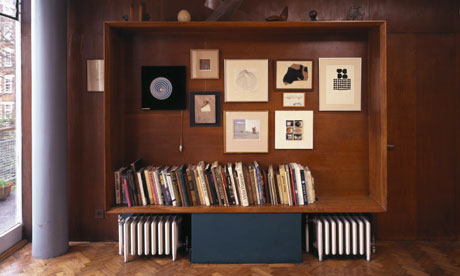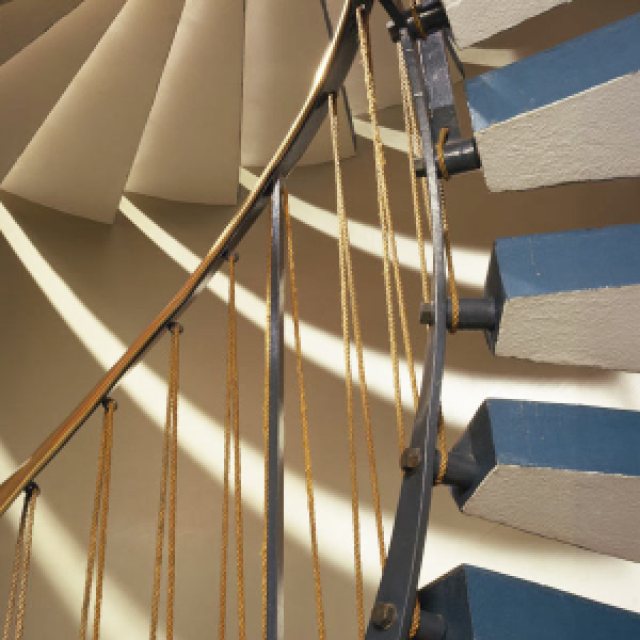var linkwithin_site_id = 519459; 
In many ways, no. 2 Willow Road doesn’t look that remarkable from the outside. There is nothing overtly Modernist about the exterior– it is not a stark white box– but in fact a red brick facade featuring similarly proportioned windows to it’s neighbouring Georgian counterparts. What is remarkable, however, are the subtle nuances once you get inside: the changes in level, the bespoke furniture designed by Goldfinger and the famous artwork by the likes of Bridget Riley and Marcel Duchamp.
The house, designed by Ernö Goldfinger– the architect of the now ‘des res’ Trellick Tower– was the family home of the Goldfinger’s from 1939 until Ernö’s death almost fifty years later in 1987. The front facade was designed as a total entity, deceptively divided into three houses by three different coloured front doors. The Goldfingers occupied the middle house, the largest, while the other two bookended maisonettes were sold to finance the project. The red, yellow and blue colours of the front doors carry on as a carefully orchestrated colour scheme on the interior: the living spaces on the first floor are bright and colourful, while the bedroom spaces on the top floor are muted and subdued. Goldfinger also highlighted the structural elements of the house, for example, the columns are painted grey to highlight that they actually had a use and weren’t just there for aesthetic reasons.





Born in Budapest in 1902, Goldfinger later studied at the École des Beaux-Arts under
Auguste Perret, one of the first architects to use reinforced concrete. Perret became a huge influence on Goldfinger, (in fact, his grey hat is still in the Goldfinger’s archive) who encouraged him against the work of Le Corbusier in favour of a more neo-classical aesthetic using historical typologies, but executed in new materials. As with other Structural Rationalists, Goldfinger believed that materials should be kept truthful: wood should look like wood, steel should look like steel. Alongside Perret, Goldfinger was also influenced by Adolf Loos and his idea of an open-planned interior. During the war, when there wasn’t much work about, Goldfinger took to writing about the psychology of architecture, arguing that it is more interesting to walk around an interior if there are changes in levels or ceiling heights. At 2 Willow Road, you enter a small and dingy hall, only to be raised by a spiral staircase into the bright and animated living and dining spaces. Again, on this level, the visitor is constantly surprised and entertained by the series of rooms, as they progress from the bottom to the top of the house. In his wife Ursula Goldfinger’s studio, there is even a small raised platform where models used to sit while she created her artwork.
The real attention to detail comes in the furniture and interior design. Goldfinger used little tricks to maximise space on the small plot: rolling doors on cupboards, sliding doors between rooms, hidden cisterns and storage units built flush into the concrete walls. Most of the furniture was designed by Goldfinger himself, from chairs with wooden backs that tilted for comfort, to open shelving with gaps at the back for airflow and also the desk in his studio with drawers that pivot out on the desk legs. Influenced by the Surrealists, and friends of Max Ernst and Lee Miller, Goldfinger continually created ‘frames within frames’. The windows of the top bedrooms are wrapped in wood to frame the view of the Heath, and the pictures in the living room are framed by a wooden screen that extends into the adjoining room to form shelves. These are all pragmatic solutions that make an essentially modernist building more tactile, more humane and more approachable.
If you get the chance, take a visit to this little gem, which tells you as much about the bohemian lifestyle of the 1930s Hampstead art scene and intelligentsia, (Mies van der Rohe apparently slept in the spare bedroom before he received his Royal Gold Medal, Bridget Riley gave a painting to them based on an argument, and novelist Ian Fleming supposedly named a villain in a Bond book Auric Goldfinger after petitioning against the construction of the Willow Road terrace) as about the life and work of Ernö Goldfinger.
Images ©National Trust Images/Dennis Gilbert
![]()
















